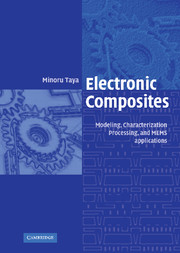Book contents
- Frontmatter
- Contents
- Preface
- Acknowledgements
- 1 Introduction
- 2 Applications of electronic composites
- 3 Foundations of modeling
- 4 Models for electronic composites based on effective medium theory
- 5 Resistor network model for electrical and thermal conduction problems
- 6 Percolation model
- 7 Lamination model
- 8 Engineering problems
- Appendix A Eshelby tensors
- Appendix B Physical constants and properties of materials
- References
- Author index
- Subject index
1 - Introduction
Published online by Cambridge University Press: 03 May 2011
- Frontmatter
- Contents
- Preface
- Acknowledgements
- 1 Introduction
- 2 Applications of electronic composites
- 3 Foundations of modeling
- 4 Models for electronic composites based on effective medium theory
- 5 Resistor network model for electrical and thermal conduction problems
- 6 Percolation model
- 7 Lamination model
- 8 Engineering problems
- Appendix A Eshelby tensors
- Appendix B Physical constants and properties of materials
- References
- Author index
- Subject index
Summary
What is an electronic composite?
“Composite” is a well-accepted word, generally referring to structural components with enhanced mechanical performance. There are a number of textbooks and review articles on these types of composites (e.g., Kelly, 1973; Tsai and Hahn, 1980; Hull, 1981; Chawla, 1987; Clyne and Withers, 1993; Daniel and Ishai, 1994; Gibson, 1994; Hull and Clyne, 1996).
Historically, composites with enhanced mechanical performance have been in existence from ancient-Egyptian time, c. 2000 BC, when bricks were made of mud, soil and straw (Exodus, Chapter 5, verse 7). Structural composites are designed primarily to enhance the mechanical properties of a matrix material by introducing reinforcement; the primary mechanical properties to be enhanced are strength, stiffness, and fracture resistance.
Normally, a composite consists of a matrix material and one kind of filler, but sometimes more than one kind of filler can be used, forming a “hybrid composite”. Depending on the matrix material, one can group composites into three basic types: polymer matrix composites (PMCs), metal matrix composites (MMCs), and ceramic matrix composites (CMCs). Among these, PMCs are the most popular type for electronic composites due to their low processing temperatures and associated cost-effectiveness.
An “electronic composite” is defined as a composite that is composed of at least two different materials and whose function is primarily to exhibit electromagnetic, thermal, and/or mechanical behavior while maintaining structural integrity.
- Type
- Chapter
- Information
- Electronic CompositesModeling, Characterization, Processing, and MEMS Applications, pp. 1 - 18Publisher: Cambridge University PressPrint publication year: 2005
- 1
- Cited by



